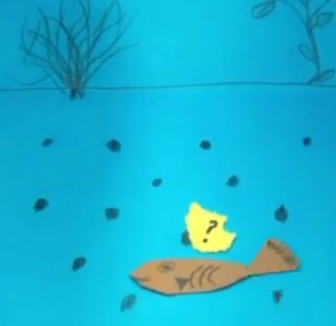
Seventh grader Elijah Soerens’ “Salami the Salmon,” in his natural habitat. See video below. Photo courtesy of Ted Malefyt.
By Becky McKendry
Great Lakes Echo
After solving the crisis of dwindling bee populations in West Michigan, and illustrating a Great Lakes ecological issue through stop-animation… how about creating an original music video to promote local geology?
All in a day’s work — or really, an academic year — for your average seventh-grader at west Michigan’s Hamilton Middle School.
Instead of wading through graded homework and exam review sheets, Hamilton’s seventh grade science class’ curriculum is comprised almost entirely of creative, collaborative projects.
These projects take the form of things like “Salami the Salmon,” a stop-animation video that student Elijah Soerens made to show how invasive species affect salmon. (Elijah’s video, along with several others, is at the end of the story.)
It is the result of the futurePrep Connections program, a partnership between the Ottawa Area School District, which is near the Lake Michigan shoreline, and local businesses.
The program promotes creative problem solving and prepares students of various grade levels for the workforce.
“One of our biggest goals is to keep on top of real world science problems,” said Ted Malefyt, a Hamilton science teacher. “Science is about reading the news, talking to people, listening to what’s going on around you.”

Barbie and Ken discuss sand dunes in Taylor Hofman’s video, “Dying Dunes.” See video below. Photo courtesy of Ted Malefyt.
Although turning concepts from words in a textbook into creative team projects is challenging, Malefyt said, students generally respond well.
“We’ve seen much higher levels of participation, proficiency and engagement,” he said.
In the three years they have used project-based learning in science class, Malefyt and his teaching partner Bob Wandel say it has allowed them to view science in a different light, too.
“These projects have evolved from PowerPoint lectures to skits to projects using GarageBand,” said Wandel.
Right now, the class is producing a music video to promote West Michigan geology.
“Most of the geology kids hear about is in the Grand Canyon or Hawaii,” Wandel said. “How many more pictures of volcanoes really help you understand though?”
Malefyt and Wandel have their eyes set on more — more interaction with the surrounding lakeshore, more evolution of project ideas and more student interaction with the Great Lakes.
“We get a lot of requests from kids who want to do more field work,” Wandel said. “We have the resources to accommodate about 20 kids, but we have around 50 or 60.
“We’re really optimistic and excited for this to grow, though.”
And as the program evolves, Malefyt and Wandel are sure they won’t run out of creative material.
“There are so many teaching resources in the Great Lakes,” said Malefyt. “You’re completely surrounded.”
And they’re pretty committed to the region.
“I’ve got a 25 mile rule,” added Wandel. “There are a lot of places I could be making more money at… but I have to be within 25 miles of a Great Lake.”
“Salami the Salmon,” by Elijah Soerens
“Going, Going, Gone,” by Morgan Haverdink
“Dying Dunes,” by Taylor Hofman
“Wolves: The Hunted,” by Eamonn Weed
“Who’s the Problem?” by Sophi Poel
Great job Morgan!!